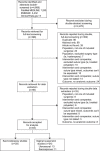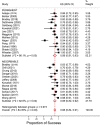Permanent Compared With Absorbable Suture in Apical Prolapse Surgery: A Systematic Review and Meta-analysis
- PMID: 36649334
- PMCID: PMC9838735
- DOI: 10.1097/AOG.0000000000005032
Permanent Compared With Absorbable Suture in Apical Prolapse Surgery: A Systematic Review and Meta-analysis
Abstract
Objective: To explore how permanent compared with absorbable suture affects anatomic success in native tissue vaginal suspension (uterosacral ligament suspension and sacrospinous ligament suspension) and sacrocolpopexy with mesh.
Data sources: MEDLINE, EMBASE, and ClinicalTrials.gov were searched through March 29, 2022.
Methods of study selection: Our population included women undergoing apical prolapse surgery (uterosacral ligament suspension and sacrospinous ligament suspension and abdominal sacrocolpopexy). Our intervention was permanent suture for apical prolapse surgery, and our comparator was absorbable suture. We determined a single anatomic success proportion per study. Adverse events collected included suture and mesh exposure, surgery for suture and mesh complication, dyspareunia, and granulation tissue. Abstracts were doubly screened, full-text articles were doubly screened, and accepted articles were doubly extracted. Quality of studies was assessed using GRADE (Grading of Recommendations Assessment, Development and Evaluation) criteria. In single-arm studies using either permanent or absorbable suture, random effects meta-analyses of pooled proportions were used to assess anatomic success. In comparative studies investigating both suture types, random effects meta-analyses of pooled risk ratios were used.
Tabulation, integration, and results: Of 4,658 abstracts screened, 398 full-text articles were assessed and 63 studies were included (24 vaginal suspension [13 uterosacral ligament suspension and 11 sacrospinous ligament suspension] and 39 sacrocolpopexy). At 2-year follow-up, there was no difference in permanent compared with absorbable suture in uterosacral ligament suspension and sacrospinous ligament suspension (proportional anatomic success rate 88% [95% CI 0.81-0.93] vs 88% [95% CI 0.82-0.92]). Similarly, at 18-month follow-up, there was no difference in permanent compared with absorbable suture in sacrocolpopexy (proportional anatomic success rate 92% [95% CI 0.88-0.95] vs 96% [95% CI 0.92-0.99]). On meta-analysis, there was no difference in relative risk (RR) of success for permanent compared with absorbable suture for uterosacral ligament suspension and sacrospinous ligament suspension (RR 1.11, 95% CI 0.93-1.33) or sacrocolpopexy (RR 1.00, 95% CI0.98-1.03).
Conclusion: Success rates were similarly high for absorbable and permanent suture after uterosacral ligament suspension, sacrospinous ligament suspension, and sacrocolpopexy, with medium-term follow-up.
Systematic review registration: PROSPERO, CRD42021265848.
Copyright © 2023 The Author(s). Published by Wolters Kluwer Health, Inc.
Conflict of interest statement
Financial Disclosure: Cara L. Grimes reports providing Expert testimony for Johnson and Johnson. The other authors did not report any potential conflicts of interest.
Figures




References
Publication types
MeSH terms
LinkOut - more resources
Full Text Sources
Medical
Research Materials

